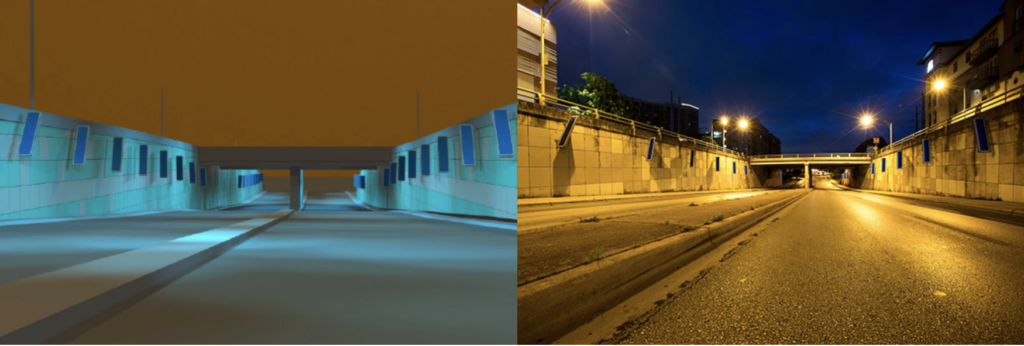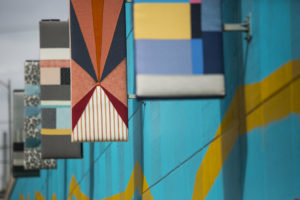Photo by Gabriel C. Pérez/KUT
The ‘Moment’ has passed. Austin’s most controversial public artwork might be coming down
Wednesday, December 9, 2020 by
Matt Largey Frank Wick remembers the first time he drove through the underpass on Lamar and saw the blue panels on the walls.
“It felt like it was art; I wasn’t sure. It was a nice moment,” said Wick, a collection manager for the city’s Art in Public Places program. “No pun intended.”
It is art – but maybe not for long. The piece, called Moments, was installed in 2003. On Thursday, City Council is set to delist Moments, along with four other works, from the city’s public art collection.
The delisting – or deaccessioning, as it’s called in the art world – could clear the way for the installation to be removed. If Council approves the request, the piece would be transferred to the city’s Transportation Department, which would ultimately decide what to do with what remains of the original installation.
RELATED | What The Heck Are Those Blue Panels Along The Lamar Underpass?
Moments was created by Austinite Carl Trominski, who’s now an architect.
“The project site is visualized as a threshold between the Urban Austin and the Natural Austin,” Trominski wrote in his proposal back in 2000. “The underpass marks a journey through the city’s self-image, between the urban center of business and entertainment to the city’s heart of natural beauty and enjoyment. This proposal intends to strengthen the expression and experience of this moment.”
The original piece included 12 blank blue signs on each side of the underpass, set at angles, at 8-degree intervals. The squares of concrete on each side of the underpass were painted green and brown. Then there was a solar-powered lighting system that bathed the underpass in blue light at night.
The city paid $45,000 for the artwork.

The original rendering for ‘Moments’ at night (left) and what it looked like in 2017. (Carl Trominski/AIPP & Gabriel C. Pérez/KUT)
But it wasn’t long before the solar panels were stolen and the walls became a magnet for graffiti. Two of the panels were heavily damaged and put into storage.
Seventeen years later, the piece just isn’t what the artist intended.
“While I realize that no artwork lasts indefinitely, the original hope was that Moments would be maintained and kept in good repair for many years,” Trominski wrote in a letter to the city this year in support of removing the installation due to its deteriorating condition. “This and general site conditions have created an ongoing less-than-ideal situation for the original concept.”
The artist has asked that no part of the piece be reused, except for recycling. He also asked to witness any demolition and that he get to keep one of the blue panels.
“He would prefer that it not be up if it’s not going to sort of be what it was intended in the beginning,” said Wick, the collection manager.
On a personal note, I’ve always loved Moments. It’s a relic of a weirder time in Austin. It’s some of the most public public art here, because tens of thousands of people experience it every day, driving or biking or walking by it. It never fails to get my attention.
I feel bad for the Austinites of the future who will never get to gaze upon it and think, “Huh?”

The temporary installation in the underpass by artist Laurie Frick covered the panels from ‘Moments’ in fabric and painted the walls in bright colors. (Gabriel C. Pérez/KUT)
“One of the things I’ve always loved about this piece is how much conversation it generates. People definitely have feelings about it. And they want to talk about them,” Sue Lambe, the program manager for AIPP, said. “I love that it’s created this dialogue around art or ‘What is art?’ for Austin. So those people that will remember this, the piece will always be alive for them.”
A couple of years ago, the underpass walls were temporarily painted bright blue with colorful zigzagging stripes. The blue panels were covered with fabric.
And a new temporary installation is going in. The nonprofit Raasin in the Sun is putting up a pandemic-themed piece aimed at promoting physical and mental health.
This story was produced as part of the Austin Monitor’s reporting partnership with KUT.
The Austin Monitor’s work is made possible by donations from the community. Though our reporting covers donors from time to time, we are careful to keep business and editorial efforts separate while maintaining transparency. A complete list of donors is available here, and our code of ethics is explained here.
You're a community leader
And we’re honored you look to us for serious, in-depth news. You know a strong community needs local and dedicated watchdog reporting. We’re here for you and that won’t change. Now will you take the powerful next step and support our nonprofit news organization?








